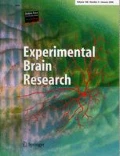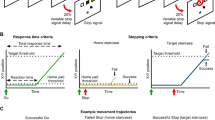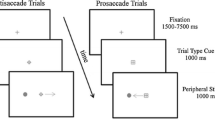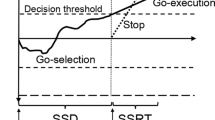Abstract
A goal-directed flexible behavior warrants our ability to timely inhibit impending movements deemed inappropriate due to an abrupt change in the context. Race model of countermanding rapid saccadic eye movement posits a competition between a preparatory GO process and an inhibitory STOP process rising to reach a fixed threshold. Stop-signal response time (SSRT), which is the average time STOP takes to rise to the threshold, is widely used as a metric to assess the ability to revoke a movement. A reliable estimation of SSRT critically depends on the assumption of independence between GO and STOP process, which has been violated in many studies. In addition, the physiological correlate of stochastic rise of STOP process to a threshold remains unsubstantiated thus far. Here, we introduce a method to estimate the efficacy of inhibitory control on the premise of an alternative model that assumes deceleration of GO process following the stop-signal onset. The average reaction time increased exponentially with the increase in the maximum duration available to attenuate GO process by the stop-signal. Our method estimates saccade procrastination in anticipation of the stop-signal, and the rate of increase in attenuation on GO process. Unlike SSRT, these new metrics are independent of how the stopping performance varies with the delay between go- and stop-signal onsets. We reckon that these metrics together qualify to be considered as an efficient alternative to SSRT for the estimation of individuals’ ability to countermand saccades, especially in cases when the assumptions of race model are no longer valid.




Similar content being viewed by others
Data availability
Data may be shared in its raw form for review purpose.
References
Åkerfelt A, Colonius H, Diederich A (2006) Visual-tactile saccadic inhibition. Exp Brain Res 169:554–563
Albin RL, Young AB, Penney JB (1989) The functional anatomy of basal ganglia disorders. Trends Neurosci 12:366–375
Alderson RM, Rapport MD, Kofler MJ (2007) Attention-deficit/hyperactivity disorder and behavioral inhibition: a meta-analytic review of the stop-signal paradigm. J Abnorm Child Psychol 35:745–758
Alexander GE, Crutcher MD (1990) Functional architecture of basal ganglia circuits: neural substrates of parallel processing. Trends Neurosci 13:266–271
Armstrong IT, Munoz DP (2003) Inhibitory control of eye movements during oculomotor countermanding in adults with attention-deficit hyperactivity disorder. Exp Brain Res 152:444–452
Aron AR (2011) From reactive to proactive and selective control: developing a richer model for stopping inappropriate responses. Biol Psychiatry 69:e55–e68
Aron AR, Poldrack RA (2006) Cortical and subcortical contributions to stop signal response inhibition: role of the subthalamic nucleus. J Neurosci 26:2424–2433
Aron AR, Verbruggen F (2008) Stop the presses: dissociating a selective from a global mechanism for stopping. Psychol Sci 19:1146–1153
Aron AR, Durston S, Eagle DM et al (2007) Converging evidence for a fronto-basal-ganglia network for inhibitory control of action and cognition. J Neurosci 27:11860–11864
Aron AR, Robbins TW, Poldrack RA (2014) Inhibition and the right inferior frontal cortex: one decade on. Trends Cogn Sci 18:177–185
Association WM (2008) World medical association Declaration of Helsinki. Ethical principles for medical research involving human subjects. https://www.wma.net/wp-content/uploads/2018/07/DoH-Oct2008.pdf. Accessed 29 Mar 2020
Badcock JC, Michie PT, Johnson L, Combrinck J (2002) Acts of control in schizophrenia: dissociating the components of inhibition. Psychol Med 32:287–297
Baldwin SA, Fellingham GW (2013) Bayesian methods for the analysis of small sample multilevel data with a complex variance structure. Psychol Methods 18:151
Band GPH, Van Der Molen MW, Logan GD (2003) Horse-race model simulations of the stop-signal procedure. Acta Psychol 112:105–142
Becker W, Jürgens R (1979) An analysis of the saccadic system by means of double step stimuli. Vis Res 19:967–983
Bekker EM, Overtoom CC, Kenemans JL et al (2005) Stopping and changing in adults with ADHD. Psychol Med 35:807–816
Bellgrove MA, Chambers CD, Vance A et al (2006) Lateralized deficit of response inhibition in early-onset schizophrenia. Psychol Med 36:495–505
Beuk J, Beninger RJ, Paré M (2014) Investigating a race model account of executive control in rats with the countermanding paradigm. Neuroscience 263:96–110
Bilder RM, Sabb FW, Cannon TD et al (2009) Phenomics: the systematic study of phenotypes on a genome-wide scale. Neuroscience 164:30–42
Bissett PG (2013) The countermanding task revisited: mimicry of race models. J Neurosci 33:12150–12151
Bissett PG (2014) Evaluating the independent race model for the stop signal paradigm: context independence is violated at short stop signal delays. Dissertation, Vanderbilt University
Bissett PG, Poldrack RA, Logan GD (2019) Severe violations of independence in response inhibition tasks are pervasive and consequential. PsyArXiv. https://doi.org/10.31234/osf.io/kpa65
Boehler CN, Appelbaum LG, Krebs RM et al (2012) The influence of different stop-signal response time estimation procedures on behavior–behavior and brain–behavior correlations. Behav Brain Res 229:123–130
Bompas A, Campbell AE, Sumner P (2020) Cognitive control and automatic interference in mind and brain: a unified model of saccadic inhibition and countermanding. Psychol Rev. https://doi.org/10.1037/rev0000181
Boucher L, Palmeri TJ, Logan GD, Schall JD (2007) Inhibitory control in mind and brain: an interactive race model of countermanding saccades. Psychol Rev 114:376
Brown SD, Heathcote A (2008) The simplest complete model of choice response time: linear ballistic accumulation. Cogn Psychol 57:153–178
Brown JW, Hanes DP, Schall JD, Stuphorn V (2008) Relation of frontal eye field activity to saccade initiation during a countermanding task. Exp Brain Res 190:135
Cabel DWJ, Armstrong IT, Reingold E, Munoz DP (2000) Control of saccade initiation in a countermanding task using visual and auditory stop signals. Exp Brain Res 133:431–441
Camalier CR, Gotler A, Murthy A et al (2007) Dynamics of saccade target selection: race model analysis of double step and search step saccade production in human and macaque. Vis Res 47:2187–2211
Catani M, De Schotten MT (2008) A diffusion tensor imaging tractography atlas for virtual in vivo dissections. Cortex 44:1105–1132
Chamberlain SR, Fineberg NA, Blackwell AD et al (2006) Motor inhibition and cognitive flexibility in obsessive-compulsive disorder and trichotillomania. Am J Psychiatry 163:1282–1284
Chen W, de Hemptinne C, Miller AM et al (2020) Prefrontal-subthalamic hyperdirect pathway modulates movement inhibition in humans. Neuron. https://doi.org/10.1016/j.neuron.2020.02.012
Chikazoe J, Jimura K, Hirose S et al (2009) Preparation to inhibit a response complements response inhibition during performance of a stop-signal task. J Neurosci 29:15870–15877
Coe BC, Munoz DP (2017) Mechanisms of saccade suppression revealed in the anti-saccade task. Philos Trans R Soc B Biol Sci 372:20160192
Colonius H, Diederich A (2018) Paradox resolved: stop signal race model with negative dependence. Psychol Rev 125:1051
Colonius H, Özyurt J, Arndt PA (2001) Countermanding saccades with auditory stop signals: testing the race model. Vis Res 41:1951–1968
Cronbach LJ, Meehl PE (1955) Construct validity in psychological tests. Psychol Bull 52:281
Eagle DM, Robbins TW (2003) Inhibitory control in rats performing a stop-signal reaction-time task: effects of lesions of the medial striatum and d-amphetamine. Behav Neurosci 117:1302
Elchlepp H, Lavric A, Chambers CD, Verbruggen F (2016) Proactive inhibitory control: a general biasing account. Cogn Psychol 86:27–61
Emeric EE, Brown JW, Boucher L et al (2007) Influence of history on saccade countermanding performance in humans and macaque monkeys. Vis Res 47:35–49
Fillmore MT, Rush CR (2002) Impaired inhibitory control of behavior in chronic cocaine users. Drug Alcohol Depend 66:265–273
Frank MJ (2006) Hold your horses: a dynamic computational role for the subthalamic nucleus in decision making. Neural Netw 19:1120–1136
Gulberti A, Arndt P, Colonius H (2014) Stopping eyes and hands: evidence for non-independence of stop and go processes and for a separation of central and peripheral inhibition. Front Hum Neurosci 8:61
Hanes DP, Carpenter RHS (1999) Countermanding saccades in humans. Vis Res 39:2777–2791
Hanes DP, Schall JD (1995) Countermanding saccades in macaque. Vis Neurosci 12:929–937
Hanes DP, Schall JD (1996) Neural control of voluntary movement initiation. Science 80(274):427–430
Hanes DP, Patterson WF, Schall JD (1998) Role of frontal eye fields in countermanding saccades: visual, movement, and fixation activity. J Neurophysiol 79:817–834
Hasegawa RP, Peterson BW, Goldberg ME (2004) Prefrontal neurons coding suppression of specific saccades. Neuron 43:415–425
Hox JJ, van de Schoot R, Matthijsse S (2012) How few countries will do? Comparative survey analysis from a Bayesian perspective. Surv Res Methods 6(2):87–93. https://doi.org/10.18148/srm/2012.v6i2.5033
Indrajeet I, Ray S (2019) Detectability of stop-signal determines magnitude of deceleration in saccade planning. Eur J Neurosci 49:232–249
Jana S, Hannah R, Muralidharan V, Aron AR (2020) Temporal cascade of frontal, motor and muscle processes underlying human action-stopping. Elife 9:e50371
Jantz JJ, Watanabe M, Everling S, Munoz DP (2013) Threshold mechanism for saccade initiation in frontal eye field and superior colliculus. J Neurophysiol 109:2767–2780
JASP Team (2019) JASP (version 0.11.1) [computer software]
Joti P, Kulashekhar S, Behari M, Murthy A (2007) Impaired inhibitory oculomotor control in patients with Parkinson’s disease. Exp Brain Res 177:447–457
Lappin JS, Eriksen CW (1966) Use of a delayed signal to stop a visual reaction-time response. J Exp Psychol 72(6):805
Lau MA, Christensen BK, Hawley LL et al (2007) Inhibitory deficits for negative information in persons with major depressive disorder. Psychol Med 37:1249–1259
Lee S-Y, Song X-Y (2004) Evaluation of the Bayesian and maximum likelihood approaches in analyzing structural equation models with small sample sizes. Multivar Behav Res 39:653–686
Leotti LA, Wager TD (2010) Motivational influences on response inhibition measures. J Exp Psychol Hum Percept Perform 36:430
Leung H-C, Cai W (2007) Common and differential ventrolateral prefrontal activity during inhibition of hand and eye movements. J Neurosci 27:9893–9900
Li C-SR, Yan P, Sinha R, Lee T-W (2008) Subcortical processes of motor response inhibition during a stop signal task. Neuroimage 41:1352–1363
Li CR, Luo X, Yan P et al (2009) Altered impulse control in alcohol dependence: neural measures of stop signal performance. Alcohol Clin Exp Res 33:740–750
Lipszyc J, Schachar R (2010) Inhibitory control and psychopathology: a meta-analysis of studies using the stop signal task. J Int Neuropsychol Soc 16:1064–1076
Lo C-C, Boucher L, Paré M et al (2009) Proactive inhibitory control and attractor dynamics in countermanding action: a spiking neural circuit model. J Neurosci 29:9059–9071
Logan GD (1981) Attention, automaticity, and the ability to stop a speeded choice response. Atten Perform IX:205–222
Logan GD (1994) On the ability to inhibit thought and action: a users’ guide to the stop signal paradigm. In: Dagenbach D, Carr TH (eds) Inhibitory processes in attention, memory, and language. Academic Press, San Diego, CA, pp 189–239
Logan GD, Cowan WB (1984) On the ability to inhibit thought and action: a theory of an act of control. Psychol Rev 91:295–327
Logan GD, Cowan WB, Davis KA (1984) On the ability to inhibit simple and choice reaction time responses: a model and a method. J Exp Psychol Hum Percept Perform 10:276
Logan GD, Yamaguchi M, Schall JD, Palmeri TJ (2015) Inhibitory control in mind and brain 2.0: blocked-input models of saccadic countermanding. Psychol Rev 122:115
Maizey L, Evans CJ, Muhlert N, Verbruggen F, Chambers CD, Allen CP (2020) Cortical and subcortical functional specificity associated with response inhibition. NeuroImage. https://doi.org/10.1016/j.neuroimage.2020.117110
Mallet N, Schmidt R, Leventhal D et al (2016) Arkypallidal cells send a stop signal to striatum. Neuron 89:308–316
Marzocchi GM, Oosterlaan J, Zuddas A et al (2008) Contrasting deficits on executive functions between ADHD and reading disabled children. J Child Psychol Psychiatry 49:543–552
Matzke D, Love J, Wiecki TV et al (2013) Release the BEESTS: Bayesian estimation of ex-Gaussian stop-signal reaction time distributions. Front Psychol 4:918
Matzke D, Hughes M, Badcock JC et al (2017a) Failures of cognitive control or attention? The case of stop-signal deficits in schizophrenia. Atten Percept Psychophys 79:1078–1086
Matzke D, Love J, Heathcote A (2017b) A Bayesian approach for estimating the probability of trigger failures in the stop-signal paradigm. Behav Res Methods 49:267–281
Matzke D, Verbruggen F, Logan GD (2018) The stop-signal paradigm. Stevens’ Handb Exp Psychol Cogn Neurosci 5:1–45
Middlebrooks PG, Zandbelt BB, Logan GD, Palmeri TJ, Schall JD (2020) Countermanding perceptual decision-making. iScience 23(1):100777. https://doi.org/10.1016/j.isci.2019.100777
Munoz DP, Waitzman DM, Wurtz RH (1996) Activity of neurons in monkey superior colliculus during interrupted saccades. J Neurophysiol 75:2562–2580
Muthén B, Asparouhov T (2012) Bayesian structural equation modeling: a more flexible representation of substantive theory. Psychol Methods 17:313
Noorani I, Carpenter RHS (2016) The LATER model of reaction time and decision. Neurosci Biobehav Rev 64:229–251
Ollman RT (1973) Simple reactions with random countermanding of the “go” signal. Atten Perform 4:571–581
Özyurt J, Colonius H, Arndt PA (2003) Countermanding saccades: evidence against independent processing of go and stop signals. Percept Psychophys 65:420–428
Pani P, Giarrocco F, Giamundo M et al (2018) Visual salience of the stop signal affects the neuronal dynamics of controlled inhibition. Sci Rep 8:14265
Paré M, Hanes DP (2003) Controlled movement processing: superior colliculus activity associated with countermanded saccades. J Neurosci 23:6480–6489
Poldrack RA, Congdon E, Triplett W et al (2016) A phenome-wide examination of neural and cognitive function. Sci Data 3:160110
Ray S, Schall JD, Murthy A (2004) Programming of double-step saccade sequences: modulation by cognitive control. Vis Res 44:2707–2718
Ray S, Pouget P, Schall JD (2009) Functional distinction between visuomovement and movement neurons in macaque frontal eye field during saccade countermanding. J Neurophysiol 102:3091–3100
Ray S, Bhutani N, Kapoor V (2011) Trans-saccadic processing of visual and motor planning during sequential eye movements. Exp Brain Res 215:13–25
Ray S, Bhutani N, Murthy A (2012) Mutual inhibition and capacity sharing during parallel preparation of serial eye movements. J Vis 12:17
Rubia K, Smith AB, Brammer MJ, Taylor E (2003) Right inferior prefrontal cortex mediates response inhibition while mesial prefrontal cortex is responsible for error detection. Neuroimage 20:351–358
Rubia K, Smith AB, Taylor E, Brammer M (2007) Linear age-correlated functional development of right inferior fronto-striato-cerebellar networks during response inhibition and anterior cingulate during error-related processes. Hum Brain Mapp 28:1163–1177
Salinas E, Stanford TR (2013) The countermanding task revisited: fast stimulus detection is a key determinant of psychophysical performance. J Neurosci 33:5668–5685
Savostyanov AN, Tsai AC, Liou M et al (2009) EEG-correlates of trait anxiety in the stop-signal paradigm. Neurosci Lett 449:112–116
Schall JD (2004) On building a bridge between brain and behavior. Annu Rev Psychol 55:23–50
Schall JD, Stuphorn V, Brown JW (2002) Monitoring and control of action by the frontal lobes. Neuron 36:309–322
Schall JD, Palmeri TJ, Logan GD (2017) Models of inhibitory control. Philos Trans R Soc B Biol Sci 372:20160193
Schaum M, Pinzuti E, Sebastian A et al (2020) Cortical network mechanisms of response inhibition. BioRxiv. https://doi.org/10.1101/2020.02.09.940841
Schmidt R, Leventhal DK, Mallet N et al (2013) Canceling actions involves a race between basal ganglia pathways. Nat Neurosci 16:1118–1124
Shanahan MA, Pennington BF, Yerys BE et al (2006) Processing speed deficits in attention deficit/hyperactivity disorder and reading disability. J Abnorm Child Psychol 34:584
Sharika KM, Neggers SFW, Gutteling TP et al (2013) Proactive control of sequential saccades in the human supplementary eye field. Proc Natl Acad Sci 110:E1311–E1320
Sharp DJ, Bonnelle V, De Boissezon X et al (2010) Distinct frontal systems for response inhibition, attentional capture, and error processing. Proc Natl Acad Sci 107:6106–6111
Shenoy P, Rao RP, Yu AJ (2010) A rational decision-making framework for inhibitory control. In: Proceedings of the 23rd international conference on neural information processing systems, vol 2, pp 2146–2154, December 2010
Smittenaar P, Rutledge RB, Zeidman P et al (2015) Proactive and reactive response inhibition across the lifespan. PLoS ONE 10:e0140383
Stegmueller D (2013) How many countries for multilevel modeling? A comparison of frequentist and Bayesian approaches. Am J Pol Sci 57:748–761
Stenling A, Ivarsson A, Johnson U, Lindwall M (2015) Bayesian structural equation modeling in sport and exercise psychology. J Sport Exerc Psychol 37:410–420
Stuphorn V, Schall JD (2006) Executive control of countermanding saccades by the supplementary eye field. Nat Neurosci 9:925
Tan J, Iyer KK, Tang AD et al (2019) Modulating functional connectivity with non-invasive brain stimulation for the investigation and alleviation of age-associated declines in response inhibition: a narrative review. Neuroimage 185:490–512
Thakkar KN, Schall JD, Boucher L et al (2011) Response inhibition and response monitoring in a saccadic countermanding task in schizophrenia. Biol Psychiatry 69:55–62
Tombu M, Jolicœur P (2003) A central capacity sharing model of dual-task performance. J Exp Psychol Hum Percept Perform 29:3
Verbruggen F, Logan GD (2008a) Response inhibition in the stop-signal paradigm. Trends Cogn Sci 12:418–424
Verbruggen F, Logan GD (2008b) Automatic and controlled response inhibition: associative learning in the go/no-go and stop-signal paradigms. J Exp Psychol Gen 137:649
Verbruggen F, Logan GD (2009) Models of response inhibition in the stop-signal and stop-change paradigms. Neurosci Biobehav Rev 33:647–661
Verbruggen F, Logan GD (2015) Evidence for capacity sharing when stopping. Cognition 142:81–95
Verbruggen F, Aron AR, Band GPH et al (2019) A consensus guide to capturing the ability to inhibit actions and impulsive behaviors in the stop-signal task. Elife 8:e46323
Vince MA (1948) The intermittency of control movements and the psychological refractory period. Br J Psychol 38:149–157
Wanless SB, Rimm-Kaufman SE, Abry T et al (2015) Engagement in training as a mechanism to understanding fidelity of implementation of the responsive classroom approach. Prev Sci 16:1107–1116
Wessel JR, Aron AR (2013) Unexpected events induce motor slowing via a brain mechanism for action-stopping with global suppressive effects. J Neurosci 33:18481–18491
White CN, Congdon E, Mumford JA et al (2014) Decomposing decision components in the stop-signal task: a model-based approach to individual differences in inhibitory control. J Cogn Neurosci 26:1601–1614
Zandbelt BB, Vink M (2010) On the role of the striatum in response inhibition. PLoS ONE 5:e13848
Zandbelt BB, Bloemendaal M, Hoogendam JM et al (2013) Transcranial magnetic stimulation and functional MRI reveal cortical and subcortical interactions during stop-signal response inhibition. J Cogn Neurosci 25:157–174
Acknowledgements
This work was supported by a grant from the Dept. of Sc. and Tech., Govt. of India [SR/CSRI/26/2014]. The authors in order were supported by fellowships from University Grants Commission and Wellcome Trust DBT India Alliance [IA/I/13/2/501015].
Author information
Authors and Affiliations
Contributions
II collected and analysed data; SR designed the task and model, both authors wrote the manuscript.
Corresponding authors
Ethics declarations
Conflict of interest
The authors declare that they have no conflict of interest.
Additional information
Communicated by Winston D Byblow.
Publisher's Note
Springer Nature remains neutral with regard to jurisdictional claims in published maps and institutional affiliations.
Rights and permissions
About this article
Cite this article
Indrajeet, I., Ray, S. Efficacy of inhibitory control depends on procrastination and deceleration in saccade planning. Exp Brain Res 238, 2417–2432 (2020). https://doi.org/10.1007/s00221-020-05901-z
Received:
Accepted:
Published:
Issue Date:
DOI: https://doi.org/10.1007/s00221-020-05901-z




